Level crossing
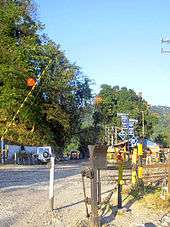
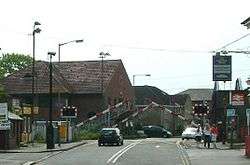
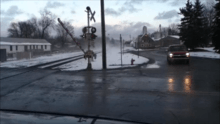
A level crossing, or grade crossing, is an intersection where a railway line crosses a road or path at the same level, as opposed to the railway line crossing over or under using a bridge or tunnel. The term also applies when a light rail line with separate right-of-way or reserved track crosses a road in the same fashion. Other names include railway crossing, road through railroad, railroad crossing, and train crossing.
History
Early level crossings had a flagman in a nearby booth who would, on the approach of a train, wave a red flag or lantern to stop all traffic and clear the tracks. Manual or electrical closable gates that barricaded the roadway were later introduced, intended to be a complete barrier against intrusion of any road traffic onto the railway. In the early days of the railways much road traffic was horsedrawn or included livestock, requiring a full barrier crossing the entire width of the road. When opened to allow road users to cross the tracks, the gates were swung across the width of the railway, preventing any pedestrians or animals getting onto the tracks. The first US patent for such crossing gates was awarded on 27 August 1867, to J. Nason and J. F. Wilson, both of Boston.[1]
Later, as motor vehicles appeared, this type of barrier became less effective, while the need for a barrier to livestock diminished dramatically. Many countries therefore replaced the fully gated crossings with weaker but more-visible barriers, and relied upon road users obeying the associated warning signals to stop.
Safety
Railroad trains have a much larger mass relative to their braking capability, and thus a far longer braking distance than road vehicles. In general, trains do not stop at level crossings but rely on vehicles and pedestrians to clear the tracks in advance.
Level crossings constitute a significant safety concern internationally. On average, each year 400 people are killed in the European Union[2] and over 300 in the United States[3] in level crossing accidents. Collisions can occur with vehicles as well as pedestrians; pedestrian collisions are more likely to result in a fatality.[4] Among pedestrians, young people (5–19 years), older people (60 years and over) and males are considered to be high risk users.[5]
As far as warning systems for road users are concerned, level crossings either have "passive" protection, in the form of various types of warning signs, or "active" protection, using automatic warning devices such as flashing lights, warning tones and boom gates.[2] Fewer collisions take place at level crossings with active warning systems.[6] Modern radar sensor systems can detect if level crossings are free of obstructions as trains approach. These improve safety by not lowering crossing barriers that may trap vehicles or pedestrians on the tracks, while signalling trains to brake until the obstruction clears (however, they cannot prevent a vehicle from moving out onto the track once it's far too late for the locomotive to slow even slightly).[7]
At railway stations, a pedestrian level crossing is sometimes provided to allow passengers to reach other platforms in the absence of an underpass or bridge. Where third rail systems have level crossings, there is a gap in the third rail over the level crossing, but this does not interrupt the power supply to trains since they have current collectors on multiple cars.
Crossings around the world
Asia
Most level crossings in Indonesia are operated automatically and commonly uses sirens in place of conventional bells, but level crossings in Thailand, and Malaysia are still largely manually operated, where the barriers are lowered using a manual switch when trains approach. A significant number of crossings are without barriers. Railway electrification in Malaysia has gradually eliminated level crossings in Peninsular Malaysia, replacing those along nearly all upgraded lines with large overhead viaducts or deep underground tunnels, and simply cutting off non-essential crossings outright. Level crossings used to exist along the KTM railway line in Singapore, but these were removed after the closure of Tanjong Pagar Railway Station, and the moving of the KTM railway station to Woodlands Train Checkpoint. But there are still some that are used on the line between Port Klang - Westport (Pulau Indah). However, it seems like only the level crossing near Port Klang Komuter Station has the barrier.
China

Speed up campaigns have largely eliminated many crossings on heavily used trunk main lines though some still do exist. Most at-grade crossings in China are for smaller industrial spur and access lines which may or may not have crossing gates.
Hong Kong
Most of Hong Kong's railway network is either underground or on elevated viaducts, meaning that level crossings are rare. However, level crossings continue to exist on the MTR Light Rail network, and one such level crossing was the site of a level crossing accident in 1994.[8]
Japan
As of 2011, there are in total about 34,000 level crossings in Japan. Many rail lines in urban areas have been changed to viaduct or underground tracks, and the number of level crossings has decreased. Similarly to United States school buses, but unlike many other countries, all cars and bicycles must stop before proceeding over any level crossing in Japan, as required by the Road Traffic Act, unless the crossing is controlled by the addition of a traffic light, called a fumikiri shingo. If the light is green, it is not necessary to stop at the level crossing.[9]
On some busy rail lines in Tokyo, Osaka and Nagoya, so many trains pass that some level crossings are almost always closed. In some cases more than 50 trains pass in an hour and the crossing opens only two minutes during that interval, causing serious traffic congestion and inconvenience.(ja:開かずの踏切) This could be rectified by eliminating level crossings.
The crossing crashes with major severe (4 or more) victims counted from 1958 until 1971 in Japan. New settlement of level crossing has been inhibited by the law. As well as construction of viaduct or overpass/underpass, the obstacle warning button or automatic obstacle detection device at many of level crossings activates crossing emergency warning light and they can stop or speed down the train notably. However, 111 people died by crossing accident in 2010, while 218 died by accidental or intentional hit at the platform. [10]
Taiwan
As most railways in Taiwan were built during Japanese administration, railway level crossings remain very common, though many urban crossings have been eliminated when the railroads have been moved underground, e.g. segments of the Western Line in Taipei City, or abolished, e.g. the former TRA Tamsui Line that is now the Taipei Metro Tamsui Line with no level crossings.
The Act Governing the Punishment of Violation of Road traffic Regulations (zh:道路交通管理處罰條例) prescribes fines for drivers and pedestrians who commit certain classes of violations in regards to level crossings; these include disobeying flagmen, insisting to cross while a crossing's signals are active or when the gate is being lowered, crossing a passive crossing without stopping beforehand, and overtaking, making a U-turn, backing up, stopping or parking on a railway level crossing in a vehicle. Pedestrians can be fined 1200 new Taiwan dollars for a violation, drivers of non-motorized vehicles such as bicycles can be fined between 1200 and 2400 dollars, and drivers of motor vehicles can be fined up to of 6000 to 12000 new Taiwan dollars for a violation. If an accident occurs, the driver's license can also be revoked for a minimum of six years.
Accidents at railway level crossings remain a very serious concern. The Taiwan Railway Administration alone has hundreds of level crossings along its routes of slightly more than 1,100 kilometres (680 mi). In average, there is a level crossing in less than 2 kilometres (1.2 mi).[11][12] An emergency button is installed on every level crossing in the country, allowing members of the public to report emergencies at a crossing to authorities, such as stalled vehicles or other obstacles.[13]
Europe
Austria
See Germany
Belgium
Automatic level crossings in Belgium have two red lights, a "moon-white" light, electronic (previously mechanical) bells and (usually) barriers. The white light flashes for half a second at regular intervals to inform drivers and pedestrians that they can cross the level crossing, and that the signal is in working order. In some cases the white light is absent; the Belgian traffic law of 1975 does not cover that situation. The bells ring until the barriers are fully lowered and then stop. If barriers are absent the bell continues ringing throughout.
At a level crossing, any overhead electric power cables must also cross. This led to a conflict where a mainline railway that crossed one of the country's once extensive interurban tram lines (vicinal or buurtspoorweg) was electrified. In at least one location, this led to the tram overhead being dismantled.
Czech Republic
Level crossings in Czech Republic use a sign on the lights that reads "Pozor Vlak" ("Attention: Train") to warn people of a train crossing. During modernization, many level crossings have been replaced with smaller variants, only a few of the large crossings which use large lights remains in use today.
Most level crossings have a white light that flashes until the red lights flash and usually a yellow outline surrounding the crossbucks for increased visibility during nighttime.
Finland
In Finland, level crossings with warning lights have the more common red light(s) and a white light that flashes except when the red light(s) flash. Most, but not all, crossings with lights also have barriers. Full-length barriers are usually used only for pedestrian and bicycle lanes. Half-length barriers are used for motor roads, to avoid the risk of a vehicle being trapped on the tracks between the barriers. Bells begin to ring when the red lights start flashing and usually stop when the barriers have come down. Red-and-yellow crossbuck is used on both controlled and uncontrolled level crossings. If there are two or more tracks, the lower part of the cross is doubled. Only minor agricultural crossings might have no signs at all. On bigger roads there are usually also approach signs as seen in the picture. Finnish level crossings are the sixth safest in Europe. Finland's state railway system has almost 3000 level crossings, according to TraFi.[14] In Finland over the course of railway history many level crossing accidents have occurred, in comparison to other Scandinavian countries.[15] In Finland the maximum speed for trains on the rails with level crossings is 140 km/h.[16]
Germany
A Level Crossing in Germany is often called a "Bahnübergang" (German for Railroad Crossing). These crossings are different than some other level crossings throughout Europe. These crossings use yellow and red lights and a bell/alarm (some crossings do not have these though) to indicate that the crossing is active. When activating a preliminary yellow light flashes which is followed by a red light that stays lit until the train(s) have cleared the crossing. Most of these crossings usually have a lightning symbol on the crossbucks. These symbols indicate that the railway is electrified with overhead wires. After crossing the level crossing, unless there is a speed limit sign, the speed limit is the national speed limit. That is, 50 km/h for built up areas and 100 km/h outside built up areas.
Italy
Level crossings in Italy, much as in the rest of Europe, can be manned, unmanned, manual, or automated. In the Italian highway code, level crossings are called "Passaggi a Livello", often abbreviated to "P/L" on vertical and horizontal road signage.
Netherlands

Most level crossings have half barriers and bells. Those for pedestrians with an active warning system have full barriers. Three level crossings are operated remotely by staff from a traffic control center, using cameras; these have full barriers and no bells. Two level crossings for vehicles have full barriers, with a system to detect a vehicle been trapped; in this case the exit barriers are opened. Crossings with little road traffic and/or little rail traffic have no alarm, just warning signs. There are no level crossings where trains routinely run at over 140 km/h.
Warning lights and bells are activated when the train is about 1 km before the crossing, depending on line speed. 5 seconds later the barriers start closing, which takes about 10 seconds. When the barriers have closed, the bells are often set less loud. Lights and bells are stopped when the barriers have raised again. As passive warning signs there are red and white striped fences, red and white saltires for single tracks (doubled in case of two or more tracks) and sometimes advanced warning signs at 80, 160 and 240 metres.
When there is a station shortly before the level crossing and an intervening signal, the signal may remain red and the crossing open when the train approaches the station. Only after some time the crossing closes, after which the signal is pulled.
Norway
From 1998-2008 the Norwegian rail administration (Jernbaneverket) removed about 1000 level crossings, leaving about 3500 still in use. 160 kilometres per hour (99 mph) is the maximum speed for trains over level crossings.[17] In addition, Oslo's and Bergen's tram or light rail systems have some level crossings. Most lines on Oslo's metro (T-banen) are free of them. Most of the level crossings were removed from the old suburban railways in the western parts of the city, when the lines were upgraded to metro standard, but some crossings are retained on the Holmenkollen Line.
Sweden
In Sweden there are 8,500 level crossings, according to Trafikverket, the Swedish Transport Administration (former Banverket, Swedish Rail Administration). On public roads they have light signals with or without gates. On private roads there are level crossings without signals. Most accidents occur on crossings without gates. For many years there have been activities to reduce the number of accidents, usually by adding gates, or adding light signals if there were none. On the main lines many bridges have been built, and also anywhere a new road or new railway has been built. Still there are some level crossings left on the main lines. A train speed of 200 km/h is allowed in Sweden over level crossings, if there are gates and an obstacle detection unit. This unit detects cars on the track and prevents the gates from closing fully and stops the train. According to Trafikverket in 15 years there has only been one serious collision between a car and a train on such a level crossing, when a car ran through the gates just in front of the train.[18]
United Kingdom




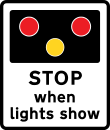

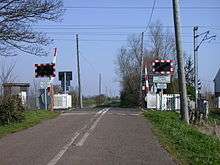


.jpg)
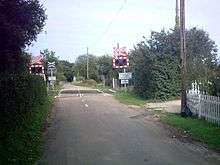
.jpg)

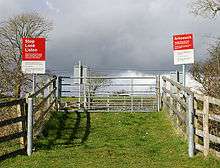

There are around 6,550 level crossings in the United Kingdom, of which about 1,500 are public highway crossings. This number is gradually being reduced as the risk of accidents at level crossings is considered high. The director of the UK Railway Inspectorate commented in 2004 that "the use of level crossings contributes the greatest potential for catastrophic risk on the railways."[19] The creation of new level crossings on the national network is banned, with bridges and tunnels being the only option, and replacing existing crossings. The cost of making significant reductions, other than by simply closing the crossings, is substantial; some commentators argue that the money could be better spent. Some 5,500 crossings are user-worked crossings or footpaths with very low usage. The removal of crossings can improve train performance and lower accident rates, as some crossings have low rail speed limits enforced on them to protect road users (e.g. AOCLs). In fact, between 1845 and 1933,[20] there was a 4 miles per hour (6.4 km/h) speed limit on level crossings of turnpike roads adjacent to stations for lines whose authorising Act of Parliament had been consolidated in the,[21] although this limit was at least sometimes (and possibly often) disregarded.[22][23][24]
History
In the United Kingdom, major crossings were normally situated within easy sight of a signal box, and usually directly adjacent to the signal box, to ensure that the signalman could verify that the road was clear before allowing a train onto the crossing by switching the semaphore signals to clear. The traditional form of road crossing on British railways from the mid-19th century consisted of two or four wooden gates (one or two on each side of the railway). These prevented road traffic from crossing when closed, and when open lay across the railway to prevent horses and livestock inadvertently escaping from the road to the railway. Many of these still exist as user-worked crossings, although these are regularly misused and accidents are frequent, one of the most recent being on the 10th April 2016.
The use of pedestrian crossings at stations in the past was common, and it was the norm for passengers to walk across the line between platforms. It is still common in many other countries, and on lines with less traffic in the UK. At Settle, for example, before the footbridge was installed in the 1990s, while passengers from Leeds walked across the line the driver's kettle was topped up with hot water. With a few exceptions, such as at Carmarthen, the remaining such crossings are on heritage railways or are used to let passengers who cannot climb stairs to the footbridge move between platforms.
Many gated crossings have been replaced by lifting barriers, which are easier to mechanise. These consist of barriers each side of the track which block the full width of the road and had two red lights that alternatively flashed, as well as an audible alarm or bell. In 1955 various European automatic crossings were visited and checked by two inspecting officers and two road engineers from the Ministry of Transport, as well as two officers from the British Transport Commission visited 46 crossings in 10 days in three countries. The report was signed on 14 March 1957, and automatic and automated crossings came into use, with the first automatically operated level crossing commencing operation at Spath near Uttoxeter in Staffordshire in May 1961.[25] Automatic half-barrier crossings later came into being after another enquiry abroad in 1963, consisting of a single arm each side of the road, which block only oncoming traffic leaving the exits clear for trapped occupants. Half barriers were considered to have an advantage as they have a lesser closure time and do not require to be interlocked with signals, but cases where impatient motorists have driven around the barriers have raised safety concerns. On lightly-used railways such as the Heart of Wales Line, many crossings are sited next to station stops or other stopping points, and were made to be crew operated. The guard pushes a plunger to operate the crossing, and on completion of the crossing sequence, the train can cross. These trainman operated crossings (TMOs) still exist today.
After the Hixon rail crash, it became clear that more warnings were needed for large vehicles at AHBs. The vehicle in question (carrying a large electrical transformer), despite being escorted by police, was struck by a train whilst crossing the tracks at 2 miles per hour (3.2 km/h) on an AHB installed a year before. The changes made to AHBs were additional signage, telephones to signal boxes and the addition of a preliminary amber light to the pair of red lights at all crossings (plus a now defunct 'Another train coming' illuminated box). This made AHBs much safer and less liable to accidents, although some have still occurred since then.
The Automatic Open Crossing (AOCLs) was introduced in 1963. These have no barriers and have an indicator light to show correct working. These crossings were cheaper than installing AHBs and were much suited to quiet country lanes, which is why many more were installed in the 70s, albeit destined to be replaced by AOCRs (Automatic Open Crossing Remotely monitored) as they had a greater line speed potential and were even cheaper than AOCLs. These continued to be installed until the Lockington rail crash occurred in 1986, which saw the demise of these type of crossing.
Since then, more upgrades have happened and the use of CCTV (and the use of obstacle detection systems since 2013) has increased. The Ufton Nervet rail crash in 2007 was an eye-opener and crossings have been closed or upgraded to Automatic Barrier Crossing Locally monitored (ABCL) status in that time (The addition of barriers to an AOCL). In 2013 also, it was seen that the AOCLs on the network were extremely dangerous and a scheme to eradicate them was put forward. In order to do it quickly and cheaply, the full conversion to ABCL status was not done, and instead the simple addition of barriers to create an AOCL+B was the go to option. Upgrades and closures still continue into the future.
Safety
After the Ufton Nervet rail crash, there have been increased efforts to review the placing of level crossings and to eliminate them where this is practicable. In the UK it has also been suggested that cameras similar to the type used to detect drivers who run traffic lights be deployed at level crossings, and that penalties for ignoring signals should be much more severe.
British Transport Police typically prosecute motorists who jump the barriers, for either trespass or failing to conform with a traffic signal. A particular problem has been that the responsibility for road safety at crossings is entirely outside the control of the railways. In 2006 there were legal proposals to permit Network Rail to be involved in the road side safety of crossings. This would allow the introduction of anti-slip surfaces and also barriers to prevent motorists driving around crossing arms and, it is hoped, reduce the number of crossing-related deaths.
Network Rail is pursuing a policy of closing level crossings at the rate of over 100 a year in the interests of safety, and replacing them with road bridges or footbridges.[26] The number of level crossings on rail lines controlled by Network Rail went from 7,937 in 2003-04[27] to 6,322 on 19 January 2014.[28]
For the episode of British motoring television programme Top Gear on 25 February 2007, Network Rail staged an incident in which a locomotive was driven into a Renault Espace at around 80 miles per hour (130 km/h) at a level crossing at Hibaldstow, Lincolnshire to graphically illustrate the dangers of "running the risk" (see British Rail Class 31 in the media).
Types of crossing
MCG - Manually Controlled Gates
These crossings are the traditional type, with some wooden (or modern metal) gates that shut off each side of the railway off to vehicles and animals when open, and that protect the railway from vehicles when closed. These were on every crossing until technology upgraded many crossings. Some still have gates, either manually operated or operated by a wheel. Despite blocking the railway off entirely, there have been virtually no accidents at gated crossings, with the last being at Lingwood, Norfolk in which a railhead treatment train crashed into the gates at a crossing in the village.
MCB - Manually Controlled Barriers
The first of this type was at a crossing in the town of Spath, near Uttoxeter in Staffordshire. The crossing has lights and alarms that operate when closing and full road width barriers that shut the entire road off to traffic. 125 miles per hour (201 km/h) is the maximum line speed on these lines (including 140 miles per hour (230 km/h) over crossings on the line between Peterborough and Grantham). The crossing is controlled by an adjacent signalbox, or in the case of an MCBR (Manually Controlled Barriers Remotely monitored), a signalbox no less than half a mile in clear sight of the crossing (some examples of these are at Saxmundham, Suffolk and Driffield, Yorkshire). There are some exceptions, being that some crossings may not have skirts on the barriers that hang down (e.g. Newhaven, East Sussex), or in the case of the crossings at Deganwy, Conwy, Wales, and Britannia slipway near Kingswear, Devon, the crossing may have three barriers. Another special exception recently brought into use is at Redcar, Yorkshire in which the electric gates were replaced with sliding telescopic gates to battle the wind.
MCB-CCTV - Manually Controlled Barriers with Closed Circuit Television
These crossings are controlled from a signaller via CCTV cameras mounted close to the crossing. These work the same as MCB crossings with the added bonus of video evidence of misuse or accidents. These crossings have replaced redundant signal boxes on various lines.
MCB-OD - Manually Controlled Barriers with Obstacle Detection systems
These crossings are MCBs with the addition of obstacle detection equipment, developed and tested at a level crossing near Hoscar, Lancashire in 2013. These use cameras to detect if the crossing is blocked by any vehicle (and cameras to record number plates), as well as lasers and reflectors to scan the crossing and see if the path of the laser is blocked. These are becoming common practice on some lines, such as the East Coastway Line and the Peterborough to Lincoln Line. These systems have also been trialled with the new S60 barriers like the type used in America, which use electrics rather than hydraulics.
MCB-OC - Manually Controlled Barrier crossing On Call
These crossings are the exact same as MCB-CCTV crossings except the barriers stay down and the lights off. When a user wants to cross, they have to press a button to notify the signaller, and then the barriers raise (if there is no train). There are only a handful of these in the UK, one being at Barnetby, Lincolnshire.
AHBC - Automatic Half Barrier Crossing
These crossings have two half barriers that block the entrance lanes to the crossing as well as lights and audible alarms. These crossings are entirely independent and do not interlock with any signals on the line, although they are monitored by a signaller to check for any failures. Existing since the fist automatic crossings, these are common on back lanes and becoming less common at stations, as they are not as safe as a MCB crossing. 100 miles per hour (160 km/h) is the maximum line speed over these crossings and the maximum number of lines is two. Network Rail is trying to make AHBCs safer by adding the brand of speaking E2S alarms to crossings, in order to alert drivers and persons using the crossing of second trains approaching, as many drivers become impatient at these crossings.
AOCR - Automatic Open Crossing Remotely monitored
These crossings were popular in the 1980s when they were created, as they lowered costs due to the lack of barriers and they could be used on country lanes. Acting the same as an AHBC, they do not interlock with signals and they had a 100 miles per hour (160 km/h) line speed. After the Lockington rail crash, their demise began, and now only three still exist; oddly, one each in England, Scotland and Wales at Pickering (Yorkshire), near Keith (Moray), and near Abergynolwyn (Gwynedd) respectively.
AOCL - Automatic Open Crossing Locally monitored
These crossings are losing numbers in the UK now as many have had barriers added. They have a driver's indicator light that acts as a signal, telling the driver if the crossing has operated correctly.
ABCL - Automatic Barrier Crossing Locally monitored
These crossings were the upgraded version of AOCLs, and are AOCL rebuilds, with the addition of barriers and the relevant signage; basically, a whole upgrade. These have stopped increasing in numbers as they are too costly to build and the more favoured option (AOCL+B) has prevailed.
AOCL+B - Automatic Open Crossing Locally monitored + Barriers
These have existed since 2013, the first being at Ardrossan, North Ayrshire, and are the cheap version of the ABCL. Only barriers are added in an AOCL upgrade and nothing more.
TMO - Trainman Operated Crossing
On small branch lines (e.g. Cambrian Line), these crossings prevail as they are operated by the driver or the guard on a train wanting to cross a road. A button by a signal or stop board is the activator.
MWL - Miniature Warning Light crossing
These crossings are basically farm crossings with a small set of red and green lights in order to alert users of approaching trains, rather than them having to decide if it is safe themselves.
Open
The open crossing only really exists on underused lanes on lines with low rail traffic. With a speed limit of 5 miles per hour (8.0 km/h) and no lights or barriers/gates, these are rare and only noticeable by the signage and St Andrew's Cross.
UWC - User Worked Crossing
The most common type of crossing on the railway network, the most basic type also. These are either a footpath crossing, a crossing with gates and instructions, or a crossing with a telephone to the nearest signalbox. Users must read the instructions and comply in order to cross safely.
North America
Canada
Grade crossing protection practices in Canada are virtually identical to those in the United States (see below) using the same alternating flashing red lights and gate arms. The only significant differences are the crossbuck signs, which have no wording but are white with a red outline; the supplemental sign to indicate the number of tracks, which has an image of a track instead of the word "TRACKS", and has the number and track image in either red (usually for CN rail lines) or black (for CP rail lines); and the advance-warning sign, which is a yellow diamond shape with a diagram of a track crossing a straight segment of road (similar to a crossroads sign, except that the horizontal road is replaced by a track). Before changes in regulations mandated bilingual (English and French) or no-wording signs, crossbucks were nearly identical to those in the US, except that they would read "Railway Crossing" instead of "Railroad Crossing." The red lights also flash a little faster than in the United States.
Mexico
Mexico has also begun to install US-style crossing signals on some of its KCS de Mexico, Ferromex, & Ferrosur rail lines; however the majority of rail crossings in Mexico remain unsignalled, marked only with a crossbuck. The crossing devices are very similar to the US models, sporting larger lights. The crossbucks read "Cruce de ferrocarril", "Crucero ferrocarril", or "Cuidado con el tren". The majority of crossings are solar operated, and the lights flash faster than the US signals. Unfortunately, these devices are easy targets for vandals as they steal their components such as gate motors and solar panels. In many cases the gates do not lower due to vandalism or lack of maintenance. In some cases due to the lack of maintenance, the lights do not turn on at all. The rail companies, which by law are required to maintain the crossing signals, take little to no action in maintaining these devices, and the majority remain unmaintained, posing a threat to drivers.
United States
Crossing identification
Every crossing, whether above grade, below grade, or at grade, is required to be assigned a unique identifier which is a six-digit number and a trailing letter used as a checksum. This identifier is called a Grade Crossing Number, and is usually posted with a sign or sticker on the sign or equipment. This allows a particular crossing anywhere in the United States to be precisely identified as to its exact location in the event of an incident involving that crossing.
Traffic control devices
All public crossings in the United States are required to be marked by at least a crossbuck. The 2009 Manual on Uniform Traffic Control Devices requires passive crossings (crossings without actuated flashing lights or gates) to have either stop signs or yield signs in addition to the crossbuck, unless a flagger will stop traffic every time a train approaches. Normally a yield sign is used, unless it is determined that all vehicles should stop at the crossing, such as a location with poor sight distance.[29] All passive crossings must be upgraded to meet this standard by December 31, 2019.[30]
If the crossing has more than one railroad track, the crossbuck is required to have a small sign beneath it denoting the number of tracks.
As traffic on the road crossing or the rail crossing increases, safety features are increased accordingly. More heavily trafficked crossings have "automatic warning devices" (AWDs), with alternately flashing red lights to warn automobile drivers and a bell to warn pedestrians. Additional safety is attained through crossing gates that block automobiles' approach to the tracks when activated. Increasingly, crossings are being fitted with four-quadrant gates to prevent circumventing the gates.
Operation of a typical AWD-equipped railroad crossing in the United States is as follows:
- About 30 seconds before arriving at the crossing, the train trips a track circuit near the crossing, triggering the crossing signals. The lights begin to flash alternately, and a bell (or bells) mounted at the crossing begins ringing. After several seconds of flashing lights and ringing bells, the crossing gates (if equipped) begin to lower, which usually takes 5–10 seconds. Some AWDs silence the bell once the gates are fully lowered (typically seen on most Norfolk Southern and CSX crossings); most continue ringing the bells throughout (Union Pacific, BNSF Railway). Some crossings will not sound the bell at all after dark in the case that it is installed near a residential area. The lights continue to flash throughout regardless.
- About 15–20 seconds before arriving at the crossing, the train begins ringing its bell and sounding its horn in accordance with NORAC rule 14L or GCOR rule 5.8.2(7): two longs, one short, and one long. These are prolonged or repeated until the engine occupies the crossing. If the AWD is equipped with a wayside horn in accordance with FRA Quiet Zone rules, the AWD may provide the whistle signal instead of the train; however, the train is required to ring its bell regardless.
- After the train has cleared the crossing, the bells (if silenced) may begin ringing again (such as the Florida East Coast Railway), and the gates (if equipped) begin to rise. Once the gates have completely risen back to their fully raised position, all warning signals, including the lights and bells, are suppressed.
Some AWD track circuits are equipped with motion detectors that deactivate the crossing signal if the train stops or slows significantly before arriving at the crossing.
As indicated above, the pattern of the bells at each individual crossing can be different. (These bells should not be confused with the bells that are mounted on the trains.) Generally, the bells follow one of these patterns:
- The bell begins ringing when the lights begin flashing and stops when the gates have completely lowered.
- The bell begins ringing when the lights begin flashing and stops when the gates begin to go up following the passing of the train.
- The bell begins ringing when the lights begin flashing and stops when the gates have completely lowered, and then resumes ringing when the gates begin to go up, until the gates have returned to their original position.
- The final, and most common, practice is for the bells to begin ringing when the lights begin flashing and continue until the gates have gone up after the train passes.
Some level crossings that are located close to intersections with traffic lights program the signals so when the approaching train trips the track circuit, it not only activates the crossing signals, but also changes the traffic lights facing the crossing to green, to clear any traffic that may be queued on the crossing. If the intersection's stop line is right before the tracks (typically sharing the crossing's stop line), the track circuits would change the traffic lights to red (often without a yellow phase.) Some track circuits place the signals into flash mode the entire time the AWDs are active. In cases where railroads share the right of way with vehicular traffic, simple railroad preemption may cause an all-red flash in traffic lights.[31]
A few level crossings still use wigwag signals, which were developed in the early 1900s by the Pacific Electric Railway interurban system in the Los Angeles region to protect its many level crossings. Though now considered to be antique, around 100 such signals are still in use, almost all on branch lines. By law, these signals must be replaced by the now-standard alternating red lights when they are retired.
US Federal Railroad Administration regulations restrict trains to a maximum speed of 110 mph (177 km/h) at standard grade crossings. Crossings are permitted up to 125 mph (201 km/h) only if an "impenetrable barrier" is in place to block traffic when a train approaches. Crossings are prohibited at speeds in excess of 125 mph (201 km/h).[32]
A track that will run high-speed trains in excess of 120 miles per hour (190 km/h) is being tested in Illinois between Chicago and St. Louis, Missouri. Here, due to the high speed of the trains, gates that totally prevent road traffic from reaching the tracks are mandatory on all level crossings. Steel mesh nets were tested on some crossings to further prevent collisions, but these were removed because of maintenance issues in 2001.
A new device called "StopGate" has been installed at four locations, one in Madison, Wisconsin; another in Monroe, Wisconsin and two in Santa Clara, California (on a light rail system). This system resembles a fortified version of a standard crossing gate, with two larger arms blocking the entire width of the roadway and locking into a securing device on the side of the road opposite the gate pivot mechanism. The gate arms are reinforced with high-strength steel cable, which helps the gate absorb the impact of a vehicle attempting to crash through the gate. The manufacturer claims that the StopGate can stop a 2,000 kilograms (4,400 lb) truck within 13 feet (4.0 m). Already the system has been tested at the Madison crossing, when the system stopped a truck while a Wisconsin and Southern Railroad train was in the crossing.
Another new type of barrier is being tested in Michigan that is hoped will reduce the number of times drivers attempt to drive around lowered crossing gates. The new devices are called "delineators" consisting of a series of flexible bollards that raise vertically out of vertical tubes in the pavement when the crossing signal is activated. The delineators are designed so that they will not be broken and will not damage vehicles if they are hit, allowing vehicles to exit the level crossing if they are already within it when the gates are activated. The test period for the new barrier began on 5 December 2007, and ran for at least a period of 17 months.[33][34]
Locomotive equipment
In the United States and in countries following United States practices, a locomotive must have a bright headlight and ditch lights (two lights located below the headlight), a working bell, and a whistle or horn that must be sounded four times (long-long-short-long), similar to the signal for the International Morse Code letter "Q", as the train approaches the crossing.
Some American cities, in the interest of noise abatement, have passed laws prohibiting the sounding of bells and whistles; however, their ability to enforce such rules is debatable. In December 2003 the US Federal Railroad Administration published regulations that would create areas where train horns could be silenced, provided that certain safety measures were put in place, such as concrete barriers preventing drivers from circumventing the gates or automatic whistles (also called Wayside horns) mounted at the crossing (which reduce noise pollution to nearby neighborhoods). Implementation of the new "Quiet Zone" Final Rule was delayed repeatedly but was finally implemented in the summer of 2005. Rail "Quiet Zone" crossings still require bells as part of the (AWDs) in addition to the wayside horns. The wayside horns usually are sets of speakers that are directed at the crossing mounted right up on a pole. These audible devices are similar to a train horn.
Central America
Costa Rica
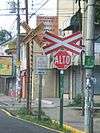
INCOFER has crossings with crossbucks as in the photo, with the words "Cuidado con el tren" (be careful of the train), as well as crossbucks without lettering, and a normal stop sign (alto). Since most crossings don't have automatic gates, the train has to blow the horn. Some crossings have warning lights.
El Salvador

If marked at all, the railroad crossing will have a sign marking it. This sign says, "Alto, Mire, Oiga" (Stop, Look, Listen). There are no gates.
Oceania
Australia

Australian railways generally follow United States practices, and they have increasingly been employing American-made crossing warning equipment, such as level crossing predictors, which are able to provide a consistent amount of warning time for trains of widely varying speeds. There are many different types of rail crossings in Australia; railways that run through rural areas often do not have barriers or even lights/bells to warn of incoming trains, while urban crossings will either have lights and bells or lights, bells, and boom gates.
In Melbourne, there are several level crossings where electrified train tracks cross roads with electrified tram tracks. These crossings are fitted with equipment to change the voltage supplied to the overhead wiring depending on the vehicle using the crossing at that point in time. Trains are severely speed-limited across these intersections. Due partly to this complication, the Victorian Government under Premier Daniel Andrews has begun removing 50 of Melbourne's most dangerous and congested level crossings. This is due to deaths and accidents that have occurred in recent years. The removals are due to complete by 2022.[35]
All cases where a train line crosses a road are classified as level crossings whether or not they are signed. A tram track in its own right-of-way crossing a road can also be classified as a level crossing if it is signed with a crossbuck reading either "TRAM WAY CROSSING" or "RAIL WAY CROSSING". Otherwise, it is considered a regular intersection and usually has either traffic lights or a give way sign facing the road (see Gallery).
Some recent innovations in Australia are to provide crossbucks with a pair of flashing yellow lights at about 200 metres (660 ft) before the level crossing, called Advance Active Warning Signals (AAWS). This is done particularly where there are curves and other visibility problems on the road. AAWS are used where road speeds are high, and braking distances are extended, or where the level crossing is obscured by blind curves or sunlight. Another innovation is to transmit level crossing warning signals by radio into the cabin of nearby vehicles. This would be particularly useful at passive crossings, which are not yet fitted with flashing lights.[36][37]
New Zealand
There are 1390 public road level crossings in New Zealand, of which 275 crossings are protected by flashing red lights, bells, and half-arm barriers; and 421 are protected by flashing red lights and bells only. The remainder are controlled by "Stop and Give Way" signs.[38] Level crossings are the responsibility of rail infrastructure owner KiwiRail Network, the New Zealand Transport Agency, and if the crossing is on a local road, the local city or district council.
On the Taieri Gorge line and the Hokitika Branch, in rural South Island, New Zealand, roads and railways share the same bridge when crossing a river, with the rail line in the road. Motorists, as well as giving way to oncoming traffic if required (the bridges have one lane) must ensure that the bridge is clear of a train, end to end, before starting to cross the bridge. For safety, trains are limited to 10 km/h (6 mph) while crossing the bridges.
In many parts of New Zealand, railway lines run parallel to and close (within 10–15 metres (33–49 ft)) to roads. Many level crossing accidents have been caused by drivers turning right into side roads crossing the railway line concentrating on finding a suitable gap in oncoming traffic so that they fail to check the railway line or notice the activated level crossing alarms until it is too late to stop. An accident of this type occurred in August 1993 at Rolleston, near Christchurch, when a cement mixer truck turned right off State Highway 1 and collided with the side of a southbound Southerner passenger train, ripping open two carriages. The accident resulted in three deaths, including the sister of New Zealand international cricketer Chris Cairns.
Major accidents

Level crossings present a significant risk of collisions between trains and road vehicles. This list is not a definitive list of the world's worst accidents and the events listed are limited to those where a separate article describes the event in question.
Runway crossings
Aircraft runways sometimes cross roads or rail lines, and require signaling to avoid collisions.
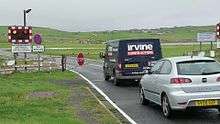
Australia
- Kingsford Smith Airport had a runway crossing, when that runway was extended. The railway was later deviated with sharp curves to avoid that runway.
- Cootamundra West, while not having an actual runway crossing, had extra low signals and telegraph wires at the railway station to improve safety for low flying aircraft landing or taking off.[55]
New Zealand
A level crossing near Gisborne, sees the Palmerston North - Gisborne Line cross one of Gisborne Airport's runways. Aircraft landing on sealed 1310-metre runway 14L/32R are signalled with two red flashing lights on either side of the runway and a horizontal bar of flashing red lights to indicate the runway south of the railway line is closed, and may only land on the 866 metres (2,841 ft) section of the runway north of the railway line. When the full length of the runway is open, a vertical bar of green lights signal to the aircraft, with regular rail signals on either side of the runway indicating trains to stop.[56][57]
Northern Ireland
- There was a runway crossing on the Belfast–Derry railway line. The runway was interlocked with conventional railway block instruments to the control tower.
See also
- At-grade intersection
- Automatic full barriers
- Billups Neon Crossing Signal
- Boom barrier
- Crossbuck
- Four-quadrant gate
- Grade separation
- Category:Level crossing accidents
- Whistle post
- Lists of rail accidents
- List of road accidents
- Wigwag
- Winston Churchill Avenue, a street crossing an airport runway
References
- ↑ Rivanna Chapter, National Railway Historical Society (2005). "This Month in Railroad History: August". Retrieved 25 August 2006.
- 1 2 Cirovic, G.; Pamucar, D. (2012). "Decision support model for prioritizing railway level crossings for safety improvements: Application of the adaptive neuro-fuzzy system". Expert Systems with Applications (In press October 2012).
- ↑ Mok, Shannon C; Savage, Ian (1 August 2005). "Why Has Safety Improved at Rail-Highway Grade Crossings?". Risk Analysis. 25 (4): 867–881. doi:10.1111/j.1539-6924.2005.00642.x.
- ↑ Australian Transport Safety Bureau (2004). "Level crossing accident fatalities" Check
|url=value (help). - ↑ Lloyd's Register Rail (2007). "Study of pedestrian behaviour at public railway crossings". Public Transport Safety Victoria. Victoria, Australia.
- ↑ Federal Railroad Administration (2006). "Railroad safety statistics: 2005 annual report". Federal Railroad Administration, Washington D.C.
- ↑ "Honeywell Radar Scanner, Advantages & Benefits" (pdf). Honeywell Regelsysteme GmbH. 11 May 2012. Retrieved 1 September 2013.
- ↑ "輕鐵 1013 輕鐵車頭嚴重損毀,司機死亡". 21 November 2008.
- ↑ http://law.jablaw.org/br_railroad
- ↑ http://www8.cao.go.jp/koutu/taisaku/h23kou_haku/zenbun/genkyo/h1/h1b2s1.html
- ↑ "Statistics of level crossings" (PDF) (in Chinese). Taiwan Railway Administration. 2002.
- ↑ "Statistics of level crossings" (PDF) (in Chinese). Taiwan Railway Administration. 2005.
- ↑ "Level crossing emergency button" (in Chinese). Taiwan Railway Administration.
- ↑ "Liikennevirasto: Tasoristeyspäivä 3.6.2014" (in Finnish). Liikennevirasto.
- ↑ "MTV: Suomi tasoristeysturmissa Pohjoismaiden kärkeä" (in Finnish). MTV Media. 26 June 2007. Retrieved 13 February 2014.
- ↑ "Liikenneturva: Tasoristeyksen ylittäminen" (in Finnish). Liikenneturva. 2013. Retrieved 8 December 2014.
- ↑ Svingheim, Njål (20 January 2009). "Der vei krysser jernbane" (in Norwegian).
- ↑ Olle, Mornell (30 June 2006). "9.4". Kartläggning av plankorsningar (pdf) (in Swedish).
- ↑ "Rail level crossings discouraged". BBC. 7 November 2004.
- ↑ Railways Clauses Consolidation Act 1845, s.48
- ↑ Railways Clauses Consolidation Act 1845
- ↑ Attorney General v London & North Western Railway Co [1900] 1 QB 78
- ↑ The requirement that trains travel at 4mph across some level crossings was abolished by the Road and Rail Traffic Act 1933, Sch 3.
- ↑ Goodman, Michael (1977). "Railways in the Law Reports" (PDF). Trent Law Journal. 1 (1): 47.
- ↑ "New Summary: Automatic "Gates" Britain's first automatically operated level crossing barriers are now in operation at Spath Level Crossing near Uttoxeter. The barriers, electronically operated by an approaching train, consist of a single pole fixed each side of the road only, and are conspicuously marked with red and white bands. Additional warning is given by flashing red lights and audible alarms.". Practical Motorist. 7 (81): 957. May 1961.
- ↑ "Level crossings". Network Rail. 2014. Retrieved 27 June 2015.
- ↑ "Railways: level crossings" (PDF). House of Commons Library. 26 January 2012. Retrieved 27 June 2015.
- ↑ "Annual Safety Performance Report 2013-14" (PDF). Rail Safety Standards Board. 2 July 2014. Retrieved 27 June 2015.
- ↑ Federal Highway Administration (2009). Manual on Uniform Traffic Control Devices. Washington, DC: United States Department of Transportation. p. 754. Retrieved 24 September 2013.
- ↑ "Proposed Revision 2009 MUTCD Marked Up to Show Proposed Revisions to Table I-2. Target Compliance Dates Established by the FHWA". Retrieved 28 February 2012.
- ↑ "Old Timey Intersection Railroad Preempts". YouTube. 12 June 2008. Retrieved 30 October 2013.
- ↑ "High-Speed Grade Crossings". Federal Railroad Administration. Archived from the original on 6 March 2012.
- ↑ Mulcahy, John (6 December 2007). "Railroad barrier put to the test". Ann Arbor News. Retrieved 7 December 2007.
- ↑ Helms, Matt (6 December 2007). "Railroad crossing in Wayne Co. to test new technology". Detroit Free Press. Archived from the original on 27 September 2013. Retrieved 7 December 2007.
- ↑ http://levelcrossings.vic.gov.au/crossings
- ↑ "Vic may use radio signals at rail crossings". Australian Broadcasting Corporation. 26 June 2007. Retrieved 30 October 2013.
- ↑ "Post A Comment".
- ↑ "Level Crossing Safety". KiwiRail. Retrieved 9 February 2012.
- ↑ "India train crash deaths reach 55". BBC. 2005-02-04. Retrieved 2015-06-22.
- ↑ Blair, Edmund (17 November 2012). "UPDATE 5-Train ploughs into school bus in Egypt, 50 killed". Reuters. Thomson Reuters.
- ↑ "Ukraine train and bus collision kills 42". BBC. 12 October 2010.
- ↑ "Slovak bus-rail crash 'kills 11'". BBC. 21 February 2009. Retrieved 21 February 2009.
- ↑ "Al Menos Once Muertos y 228 Heridos en la Mayor Tragedia con Trenes en la Ciudad en Casi 50 Años". Clarín (in Spanish). Buenos Aires. 13 September 2011. Retrieved 23 February 2012.
- ↑ "Argentina Bus and Trains Crash Killing at Least 11". BBC. 14 September 2011. Retrieved 24 February 2012.
- ↑ "Driver Sentenced In Deadly Amtrak Crash". WMAQ TV Chicago. NBC. 28 September 2004. Retrieved 19 January 2006.
- ↑ Ministry of Transport (1968). Report of the Public Inquiry into the Accident at Hixon Level Crossing on January 6, 1968. HMSO. ISBN 0-10-137060-1. Retrieved 24 September 2013.
- ↑ Oake, Dan; Doherty, Ben; Webb, Carolyn; Guerrera, Orietta (5 June 2007). "11 die in train crash". The Age. Fairfax Media. Retrieved 6 June 2007.
- ↑ Simmons, Ann M. (21 August 2008). "Metrolink killer is sentenced to 11 life terms in prison". Los Angeles Times. Tribune Company. Retrieved 21 August 2008.
- ↑ British Railway Disasters. Shepperton: Ian Allan Publishing. 1996. ISBN 0-7110-2470-7.
- ↑ Kerr, Joseph (14 May 2004). "Riding a slow train to nowhere". Sydney Morning Herald. Fairfax Media. Retrieved 11 August 2008.
- ↑ "Driver says light did not turn green - October 27, 1995". CNN. 27 October 1995. Retrieved 19 November 2008.
- ↑ "Metro-North Crash Kills 7 in Worst Accident of Railroad's History - February 3, 2015". New York Times. 3 February 2015. Retrieved 3 February 2015.
- ↑ "Seven train crash dead are named". BBC. 8 November 2004. Archived from the original on 13 June 2006. Retrieved 30 March 2010.
- ↑ "5 dead in Ottawa train-bus collision". CNN International. 2012-09-18. Retrieved 2012-09-18.
- ↑ "Cootamundra West Station". RailCorp.
- ↑ "Gisborne (NZGS) aerodrome diagram" (PDF). Civil Aviation Authority of New Zealand. 24 September 2009. Retrieved 4 January 2010.
- ↑ "Gisborne (NZGS) Operational Signal Lights" (PDF). Civil Aviation Authority of New Zealand. 4 September 2003. Retrieved 4 January 2010.
Bibliography
- Hall, Stanley; van der Mark, Peter. Level Crossings. Shepperton: Ian Allan Publishing. ISBN 978-0-7110-3308-5.
External links
| Wikimedia Commons has media related to Level crossings. |
- Web Accident Prediction System - Highway-rail crossing data from the U.S. Federal Railroad Administration, Office of Safety Analysis
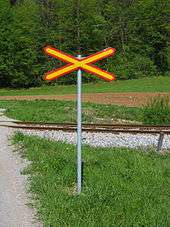
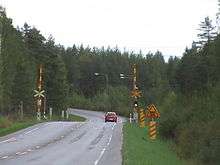
.jpg)

